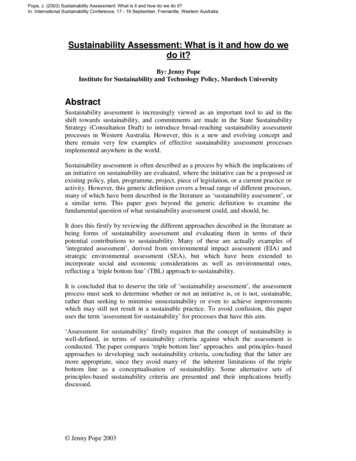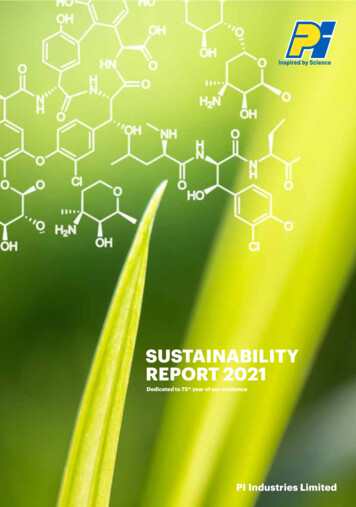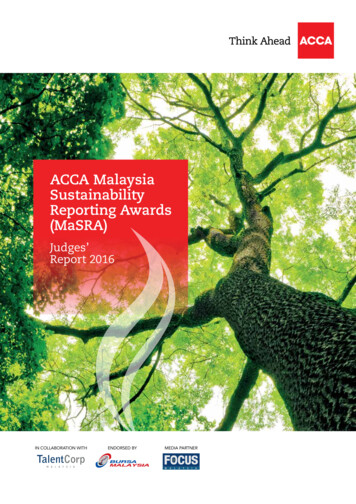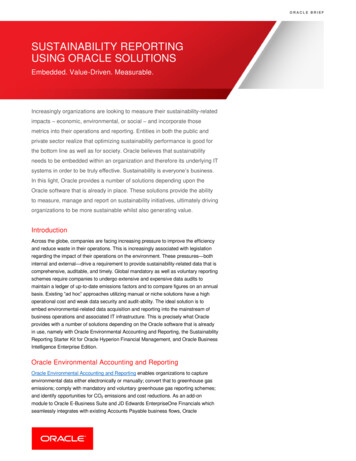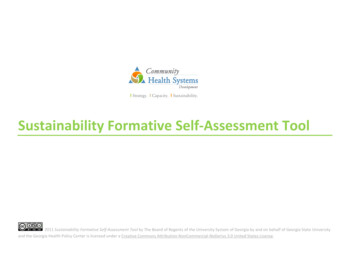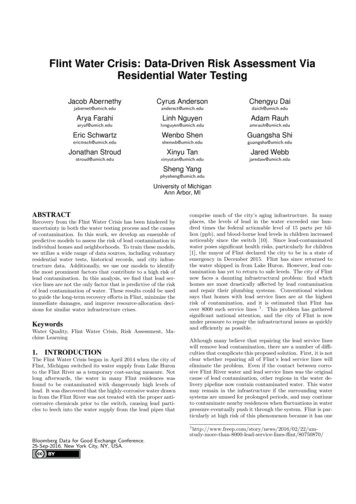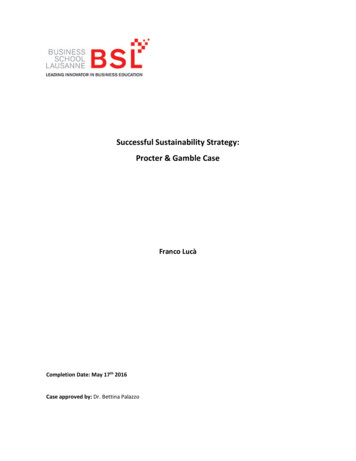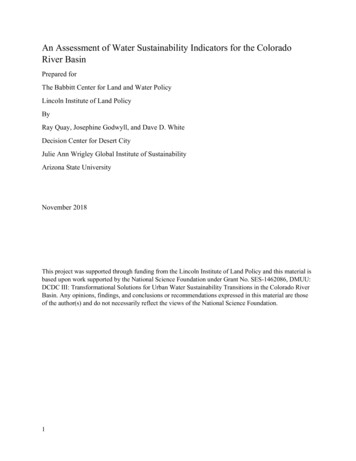
Transcription
An Assessment of Water Sustainability Indicators for the ColoradoRiver BasinPrepared forThe Babbitt Center for Land and Water PolicyLincoln Institute of Land PolicyByRay Quay, Josephine Godwyll, and Dave D. WhiteDecision Center for Desert CityJulie Ann Wrigley Global Institute of SustainabilityArizona State UniversityNovember 2018This project was supported through funding from the Lincoln Institute of Land Policy and this material isbased upon work supported by the National Science Foundation under Grant No. SES-1462086, DMUU:DCDC III: Transformational Solutions for Urban Water Sustainability Transitions in the Colorado RiverBasin. Any opinions, findings, and conclusions or recommendations expressed in this material are thoseof the author(s) and do not necessarily reflect the views of the National Science Foundation.1
AcknowledgementsWe would like to thank Tyler Micek who worked on the initial collection of water sustainabilitysystems, Bailey Kennett for her contributions early in the project, Faith Sternlieb and ZacharySugg for their questions and comments, and Liz Marquez for her project administration andreview of this report.2
Table of ContentsIntroduction . 5Defining Water Sustainability . 6Defining water sustainability Indicators . 6Purpose . 7Methodology . 7Indicator Identification . 7Indicator Assessment. 36Sustainability Assessment . 36Description . 36Sources . 37Indicators by Sustainability Framework . 40Data Assessment . 48Functional Assessment . 61Water Demand. 62Scale . 62System . 62Efficiency . 62Water Supply . 64Surface . 64Ground Water . 65Effluent and Reclaimed . 65Desalination . 65Rainwater/Storm Water Harvesting . 66Economic . 66Environmental . 66Disaster MGMT . 66Climate . 66Social Well-Being . 66Infrastructure/ Water MGMT . 67Energy . 67Legal - Regulation, and Governance . 673
What is Missing?. 67UN Sustainable Development Goals Indicators . 67Water Sensitive Cities Index . 67California Water Sustainability Indicators . 68Conclusions and Recommendations . 68Credibility, Salience, and Legitimacy, . 69Gaps and Gobs in Indicator Context . 69Recommendations . 71Appendix: Water Sustainability Indicators . 73References . 964
IntroductionWater is essential to human settlements because water is needed for many of the basic functions of humansettlement. Basic human needs include direct consumption, hygiene, and cooking. Water is also part ofthe basic systems that support human settlement including food production, transportation, and recreationas well more complex needs within fire suppression, manufacturing, and power production. Lastly,human settlements are dependent on their supporting environmental systems which also require water.Thus, an essential concept of water sustainability over the long-term water supply cannot be lower thanwater demand needed to sustain human settlement and environmental needs. Over time, systems andexternal factors that influence them change, and institutions must adapt as conditions of supply anddemand change to keep supplies at least equal to or more than demand.The water rights allocated for the Colorado River Basin exceed that which can be allocated for a normalwater flow year and are significantly over allocated for long-term drought and climate change. In order tomaintain sustainable water systems in the basin, practices and policies will have to be initiated to managesupplies and demands in order to adapt to changing conditions over time. Such policies are based on theinteraction between complex urban and environmental systems such as the economy, personal attitudes,neighborhood social dynamics, water and sewer infrastructure, natural riparian habitats, natural andaltered watershed hydraulics, natural climate and weather systems, and government regulations. Thesesystems are not static, but each are complex adaptive systems that change over time and our ability tounderstand each of these systems and their relationships is limited. Thus, estimating the current state ofthese interactions is difficult and predicting their future state is close to impossible. Yet, every time a newpublic policy is enacted to achieve some goal or solve some problem, it is an attempt to predict the impactthis policy will have on the future state of these systems. The reality is that when policies are enacted andimplemented there is no guarantee the result will be to increase water sustainability. Thus, evaluation is acritical aspect of planning for water sustainability. When we enact policy, we must also plan to assess theimpact this policy had on water sustainability. This will require us to measure the current or estimate thefuture state of water sustainability.When assessing the level and effectiveness of polices to enhance water sustainability, the outcomes ofchange we are ultimately interested in are the metrics of the policy implementation. Even though our goalis to enhance the state of water sustainability, in these cases our focus is to understand to what degree thechanges in water sustainability can be attributed to the policy. Thus, such assessment will have threecomponents.How we assess water sustainability:1) What was the state of water sustainability before the policy was implemented?2) What is the state of water sustainability after the policy was implemented?3) To what degree did the new policy contribute to the change (positive or negative) between theinitial and new state of water sustainability?To accomplish this, metrics that measure water sustainability will be needed. These metrics need toreflect not only the overall sustainability but also measures components of sustainability that are eitherrelated to or affected by water management policies. This is not as straight forward as it may seem.Water sustainability is not a static state for which one can measure the balance between supply and5
demand and declare that balance has been or has not been achieved. Human water needs are going to bedefined in terms of quality of life and will be different for different people, different regions, at differentpoints in time. Water supplies and demand are not static, changing over time and for different places.Water sustainability will be dynamic over time in terms of its definition and state. Assessing watersustainability requires a set of metrics that reflect multiple viewpoints and multiple aspects ofsustainability that relate to a wide range of possible water management policies. To develop these metricsa definition of water sustainability is needed.Defining Water SustainabilityOver the last 25 years, the concept of water sustainability has evolved from a simple aspect of supplybeing balanced with demand, to more complex and broader concepts. Hufschmidt and Tejwani (1993) ina UNESCO report defined water sustainability as, 'a set of activities that ensures that the value of theservices provided by a given water resource system will satisfy present objectives of society withoutcompromising the ability of the system to satisfy the objectives of future generations.' This is modeledaround the Brundtland Commission report language (World Commission on Environment andDevelopment 1987). This has been criticized as being too anthropogenic (Jones 2011) and laterdefinitions included natural or environmental needs as well as human needs. The California Water Plan(2013) recently defined it as, “Water sustainability is the dynamic state of water use and supply that meetstoday’s needs without compromising the long-term capacity of the natural and human aspects of the watersystem to meet the needs of future generations.” (Department of Water Resources 2013)Though these definitions reference natural or environmental systems, they are still primarilyanthropogenic, focused on the balance between human water uses and supplies, and environmental andnatural concerns defined as protecting natural resources primarily to meet human perceived needs such asrecreation or water quality. They also do not cover the broader context of resource management suggestedby Dixon and Fallon (1989) which would include management of storm waters, issues of social justiceand characterizing it more as a process of managing systems for sustainability over a long, time frame. Tobroaden this scope of a water sustainability definition, the following is suggested:Water sustainability is the long-term dynamic state of balancing water resources withhuman (economic, social, and health) and environmental needs without compromisingthe long-term capacity of the natural and human aspects of the water systems to meetthe needs of future generations.This definition includes the common water sustainability concept of a balance between supply anddemand. But this definition also covers other aspects of water sustainability related to storm water wherethe issue is managing water resources and human social systems to limit hazards to human settlementwhile not limiting the capacity of natural water systems. This definition includes a wide variety of theelements composing water resources and human needs. It includes how water is related to the economy,how it is important to social needs and systems, how it is important to human health. It also includesenvironmental needs and all the components of water resources which include the sources of water supplyas well as the systems that sustain these supplies. Thus, any process that attempts to assess the state ofwater sustainability will have to encompass all of these elements.Defining water sustainability IndicatorsOur desire to assess the state of water sustainability is rooted in our desire to maintain it at a desirablelevel. Indicators can help us to understand not only a current assessment of water sustainability, but also6
how is it changing in relationship to what is desirable. A good indicator not only is one that helps withthis assessment, but also provides insight into what is causing it to change, i.e. a problem, and how to fixthe problem. It is not practical to expect any one indicator to be a sole assessor of water sustainabilitythus, a suite of indicators will be required. This suite of indicators will be more useful if they not onlymeasure some aspect of water sustainability, but also if they are structured so it is easy to understand howthey are interrelated to each other, and how they individually and collectively are related to our desiredstate of sustainability. Given the dynamics of our water systems and the wide breadth of uses for water, itis not likely that there can be just one viewpoint of water sustainability and its desired state. Thus, a goodsuite of water sustainability indicators must also be able to represent this range of viewpoints. Watersustainability indicators will be used by a wide a wide variety of people to make tactical and strategicdecisions about a wide range of water issues. Effective indicators will need to: be credible to a wide range of public and private actors by telling a neutral unbiased butcompelling story, be salient to the issues being considered by public and private agencies, be based on data sources and methods that are rooted in traditional water resources andcommunity policy in order to be legitimate, and be accessible and easily understood by all actors, even those that are not experts.PurposeThe purpose of this report is twofold:1) Establish an annotated set of current academic and professional indicators that can be used toassess the water sustainability of the Colorado River Basin.2) Identify the needs for professional development and academic research to further define andenhance an effective water sustainability indicator system for the Colorado River Basin.MethodologyA set of indicators was compiled based on a literature review of indicator systems. A water sustainabilityframework was created based on a literature view of other frameworks. Each indicator was then assessedagainst this framework. The data sources used for each of the indicators were critically reviewed.Indicator IdentificationAn initial set of indicators was compiled based on a literature review to identify existing relevantindicator systems. Table 1 lists the 22 systems identified. An initial list of water sustainability indicatorswere extracted from these indicator systems. These indicators were then characterized based on theirattributes and a smaller set of indicators were identified based on combining similar indicators andchoosing indicators most appropriate for the Colorado River Basin. Table 3 provides a basic list of the208 final indicators and the Appendix includes a more descriptive list. The indicators were grouped into10 topics, as listed in Table 2.7
Table 1: Water Sustainability Indicator Systems ReviewedIndicator System8Brief DescriptionAgency1. UNESCO WaterQuality IndicatorsIndicators on freshwater quality at aglobal scale.UNESCO2. World WaterAssessmentProgramWorld Water Development Report(WWDR4), Managing Waterunder Uncertainty and Risk.UNESCO3. Colorado’s RiversReport CardIndicators assessing the condition ofeight rivers in Colorado.Conservation Colorado4. Canadian WaterSustainability IndexIndicators for evaluating the wellbeing of Canadian communities withrespect to fresh water.Government of CanadaPolicy Research Initiative5. City of PhoenixWater QualityIndicatorsIndicators that highlight array offactors that will influence wateravailability and water demand overthe next 50 years.City of Phoenix WaterServices Department6. Colorado RiverWatch NetworkWater QualityMonitoringIndicators for water qualitymonitoring in the Colorado RiverBasin.Colorado River WatchNetwork7. Rural SustainabilityIndicators: Outlookfor Central AmericaConceptual framework to developand use water indicators.CIAT/World Bank/UNEPProject8. Water SustainabilityResilienceIndicators that highlight resilience inwater sustainability efforts for urbanwater sector.Energy and ResourcesGroup, University ofCalifornia9. Chandler WaterResilience ScoreCardsIndicators to measure extent ofChandler’s resilience in waterrelated issues.ASU Kyl Center for WaterPolicy at Morrison Institute10. Indicators forimproved waterresourcesmanagementIndicators to measure water resourcemanagement.UN Environment
Indicator System9Brief DescriptionAgency11. Indicator system forimproved waterqualityIndicator for measuring surfacewater quality in river basins.Oliveira, R. E. S., Lima, M.M. C. L., & Vieira, J. M.(2007). An indicator systemfor surface water quality inriver basins.12. Minnesota WaterSustainabilityIndicatorsIndicators to measure watersustainability in Minnesota.Water Resources CenterUniversity of Minnesota13. National AcademiesCritical IssuesIndicatorsDiscussed indicators that measurewater sustainability.National Academy ofEngineering14. OECDenvironmentalindicatorsReviewed indicators pertaining towater related environmental issues.Organisation for EconomicCo-operation andDevelopment15. RAND AdaptationIndicatorsIndicators on adaptive use of theColorado River in changing times.RAND: Environmental,Energy, and EconomicDevelopment Program16. California WaterSustainabilityIndicatorsIndicators to measure watersustainability approach andprocesses in California.UC Davis, DWR, USEPA17. Water UKSustainabilityIndicatorsIndicators measuring watersustainability in the UK.Water UK18. Arizona WaterMeterIndicators comparing waterconservation programs in 15Arizona communities.Water Resource Advocates19. Risk andVulnerabilityIndicatorsIndicators highlighting waterresource risk and vulnerabilitytendencies.World Resource Institutes20. Water Efficiencyand ConservationIndicatorsIndicators on laws and policies thatpertain to water efficiency andconservation.Alliance for WaterEfficiency andEnvironmental LawInstitute
Indicator SystemBrief DescriptionAgency21. Colorado RiverBasin; Demand andSupply IndicatorsIndicators that measure demand andsupply concerns on the ColoradoRiver Basin.U.S Department of theInterior December 2012Bureau of Reclamation22. Sustainable WaterManagement in theWestColorado River Basin Watermanagement indicators.U.S Department of theInterior December 2012Bureau of Reclamation10
Table 2: Water Sustainability Indicator Topic CategoriesIDCategory1 Water SupplyDescriptionRelated to various aspects of watersupplied to meet human needs.2 Water DemandRelated to the human use of water.3 Economic and FinancialRelated to how water supports localand regional economies.4 EnvironmentalRelated to the water needs of naturalsystems.5 Disaster ManagementRelated to management of stormwaterand droughts.6 Climate ChangeRelated to the impact that climatechange may have on water supply anddemand.7 Social Well-BeingRelated to how water supports socialand community systems.8 Infrastructure/Water MGMT Related to the infrastructuremanagement systems needed tocollect, store, and deliver water.9 EnergyRelated to the role water plays inenergy production and the role energyplays in water treatment and delivery.10 Legal - GovernanceRelated to the legal aspects of wateruse and management.Table 3: List of Indicators egion1Total WithdrawalUpper BasinTotal amount of waterremoved from freshwatersources for use.WaterDemand2Total Blue WaterMeasured/estimated for eachcatchment. The accumulatedrunoff upstream of thecatchment plus the runoff inthe catchment.Environmental Measured/Estimated11Watershed
DevelopedIndicatorScope3Available BlueWaterTotal amount of waterWater Supplyavailable to a catchmentbefore any uses are satisfied.Calculated as all waterflowing into the catchmentfrom upstream catchmentsplus the runoff in thecatchment.Measured/EstimatedWatershed4Return Flow RatioMeasures the percent ofavailable water previouslyused and dischargedupstream as wastewater.Infrastructure/Water MGMTMeasured/EstimatedRegion5Seasonal Variability Measures variation in watersupply between months ofthe year.Water SupplyCalculatedRegion6Drought SeverityMeasures the average lengthof drought times the and thedryness of the droughtsfrom 1901-2008.DisasterMGMTCalculatedRegion7Baseline WaterStressMeasures total annual waterwithdrawals expressed as apercentage of the totalannual available blue water.Water s the percentage offreshwater amphibianspecies classified by IUCNas threatened.Environmental Measured/EstimatedRegion9Water Quality-TotalDissolved SolidsMeasures the portion ofsolids in water that can passthrough a filter of a specificpore size.Environmental Measured/EstimatedRegion11Water QualityElectricalConductivityMeasures how easilyelectricity passes throughwater.Environmental Measured/EstimatedRegion12Flood OccurrenceNumber of floods recordedfrom 1985-2011.DisasterMGMTRegion12Reported
DevelopedIndicatorScope13Media CoverageMeasures the percentage ofmedia articles in an area onwater-related issues.Social WellBeingReportedRegion14Upstream StorageMeasures the water storagecapacity available upstreamof a location relative to thetotal water supply at thatlocation.Infrastructure/Water MGMTMeasured/EstimatedWatershed15Index of nonsustainable wateruseComparison of total andagricultural water demandsto renewable water supplyindicating areas where nonsustainable practices may beoccurring.Infrastructure/Water MGMTCalculatedWatershed16Rural and urbanpopulationSpatial distribution of totalglobal population and thespatial extent and density ofhuman settlements with1,000 persons or more.EconomicReportedGlobal17Relative WaterStress IndexDomestic, industrial, andagricultural water demandper available water supply.WaterDemandCalculatedNational18Sources ofcontemporarynitrogen loadingNitrogen loading onto theland mass and aquaticsystems as a source fordelivery to the coastal zone;a measure of potential waterpollution.Environmental Measured/EstimatedNational19*Domestic andindustrial waterdemandDomestic and industrialwater ct of sedimenttrapping by largedams and reservoirsMeasures the residence timeof water held in largereservoirs; sedimenttrapping efficiency of largereservoirs.Infrastructure/Water lityMeasures the variation inwater supply between years.Water SupplyCalculatedRegion13
DevelopedIndicatorScope22Coefficient ofvariation forclimate moistureindexThe CV index for the CMIis a statistical measure ofvariability in the ratio ofplant water demand toprecipitation. Useful foridentifying regions withhighly variable climates aspotentially vulnerable toperiodic water stress and/orscarcity.Environmental CalculatedRegion23Water Reuse Index(WRI)Consecutive waterwithdrawals for domestic,industrial, and agriculturalwater use along a rivernetwork relative to availablewater supplies as a measureof upstream competition andpotential ecosystem andhuman health impacts.Water SupplyCalculatedRegion24Access toinformation,participation, andjusticeAssessment of conditionswith regard to access toinformation, participation,and justice in waterdecisions and on-goingwater reform process to givean indication of theinclusiveness of the reformprocess in watergovernance.LegalSurveyedNational25Assessing progresstowards achievingthe IntegratedWater ResourcesManagement targetMoving to a solution ifIWRM requires a series ofpreliminary steps that can bemonitored to show theprogress toward meeting thetarget.Infrastructure/Water MGMTSurveyedGlobal14
DevelopedIndicatorScope26Total actualrenewable waterresources percapita; inflow fromother countries(dependency ratio);proportion of totalactual renewablefreshwaterresourceswithdrawn.The theoretical maximumannual volume of waterresources available in acountry.Water opment stressShow to what extent currentgroundwater abstraction isor will be modifying theoriginal groundwaterregimes.Water SupplyCalculatedRegion28Dissolved NitrogenThe sum of concentrationsof dissolved inorganicnitrogen specifically nitrateand nitrite in water.Environmental Measured/EstimatedRegion29Trends incatchmentprojectionPercentage of land area setaside for protection overtime.LegalCalculatedRegion30Freshwater SpeciesPopulation TrendsIndexThe Freshwater Living PlantIndex Tracks changes infreshwater species found intemperate and tropicalfreshwater ecosystems sincethe baseline year of 1970.Environmental CalculatedRegion31Agricultural GDPas a share of totalGDPThe share of the country'sGDP derived ted land as apercentage ofcultivated landArea under irrigation as aWaterproportion of total cultivated Demandland.CalculatedNational33Proportion ofrenewable waterresources used forirrigated agricultureAgriculture waterwithdrawals as share of totalwater withdrawals.CalculatedNational15WaterDemand
DevelopedIndicatorScope34Land irrigationrelying ongroundwaterGroundwater use as share oftotal irrigation.Infrastructure/Water MGMTCalculatedGlobal35Trends in industrialwater useTrends in industrial waterwithdrawals andconsumption over the past50 ic PollutionEmissionsProportion of organic waterpollution by industrialsector.Environmental Measured/EstimatedNational37Trends in ISO14001 CertificationNumber of companies thatrevived ISO 14001certification; companieswith this certificationimprove their water useefficiency and waterproductivity reducepollution and pressure onthe water resources and theenvironment.LegalReportedGlobal38Risk and PolicyAssessmentAssessment of the efficiency Disasterof public policies for floodMGMTmitigation in terms of actualimpact on physical socialand economic features offlood disasters.SurveyedGlobal39ClimateVulnerability IndexAssesses humanvulnerability in the contextof global threats to er sector sharein total publicspendingPercentage of the nationalbudget spent in water sectorfor expanding,rehabilitating, andmaintaining water relatedinfrastructures andimproving water resourcesmanagement andEconomicReportedNational16
DevelopedIndicatorScopegovernance vis-a-vis othereconomic sectors.41Comparison ofactual to desiredlevel of publicinvestment indrinking watersupplyRatio of actual level todesired level of investmentin drinking water supply.EconomicReportedNational42Rate of operationand maintenancecost recovery forwater supply andsanitationMeasures water feesactually collected as apercent cost of operationand maintenance in watersupply and sanitation.EconomicReportedCity43Water andsanitation chargesas percentage ofvarious householdincome groupsShows how much water andsanitation charges constituteof various householdincome groups.EconomicReportedNational44Population exposedto water stressPopulation found in Relative Social WellWater Stress index setBeingthreshold.ReportedNational45Aquif
assess the water sustainability of the Colorado River Basin. 2) Identify the needs for professional development and academic research to further define and enhance an effective water sustainability indicator system for the Colorado River Basin. Methodology A set of indicators was compiled based on a literature review of indicator systems.
